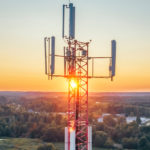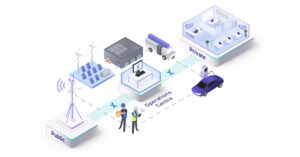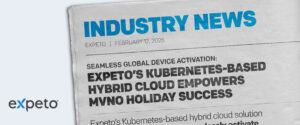On the trek to enable new ways to connect people, it seems as though we’re constantly exploring strange new worlds to disrupt the status quo, drive meaningful improvements and enable expanded capabilities. Humanity thrives on emotional connection, and I like to think that the innovations I’ve witnessed over nearly 25 years in the communications and technology space have fostered valuable new ways for humans to form stronger relationships thanks to simpler, controllable and more affordable ways to connect and interact.
5G will only make this ability to connect with others easier. But as analysts and researchers continue to assert, 5G will play a much larger role among businesses than consumers. Instead of connecting humans, we’re now turning our attention to machines. By harnessing the speed, reach and scale of 5G, enterprises are at the frontier of a transformational journey to realize a simpler, controllable and more affordable way to connect the machines and devices that power mission-critical operations.
In doing so, enterprises will enter the next generation of automation and efficiency fueled by private mobile networking that knows no bounds. The connected factories that have long been the subject of wide-eyed speculations of the far-off future will become a reality in the surprisingly near term. In many ways, this transition is already underway. Industries like mining, manufacturing and energy, to name a few, are becoming increasingly more reliant on data-generating investments that provide unprecedented operational visibility and uncover new opportunities to enhance worker safety and productivity. However, without a modern, reliable and controllable connectivity foundation, enterprises will remain unable to realize the full benefit of these data-producing technologies.
Despite a career in which I’ve worked closely with businesses of all sizes and industries, as a longtime Star Trek fan, I can’t ever seem to shake the image of a starship when I see the bold image of “enterprise.” And while it may have resulted in a few mid-meeting daydreams narrated by William Shatner, it increasingly feels appropriate as an analogy. Both are complex operations that rely on the specialized contributions of a large and diverse group of individuals to navigate an unpredictable trajectory in order to boldly go where no one has gone before. But in this analogy, instead of being powered by a “matter-antimatter warp drive” like the starship Enterprise (any other Trekkies here?), modern enterprises are fueled by connectivity to truly energize their operations.
Indeed, an enterprise in the digital age can only go as far as its connectivity enables it. And like any fuel, making it more efficient and affordable will allow you to go further, faster. That is why ultra-reliable low latency communications (URLLC) show so much promise for the future of business. But just as discussing starship warp drives and dilithium crystals can quickly become complicated and exclusionary, so has the conversation around 5G been clouded in a mess of network jargon that ultimately is not very meaningful—or interesting—to the enterprise end customer.
This inclination of mobile network operators and mobile service providers (MxOs collectively) plays a large role in why the 5G private mobile networking market is flooded with so much unsubstantiated and often unreciprocated excitement. MxOs must begin to understand that they will consistently face the same hurdles in reaching their desired enterprise audience as long as they continue to focus their conversations on the “fuel” instead of the “destination.” However, once an MxO shows they understand the enterprise struggle for controllable connectivity that seamlessly integrates next-gen technologies (like autonomous vehicles, edge compute and IoT devices), then enterprises will have a clear view of the destination. Keeping this view in sight for enterprises—a future of unprecedented operational safety, productivity and efficiency—will be the key for MxOs to secure new and continued enterprise business.
Though it may be easier said than done, and though it will likely require a cultural transformation from the top down, the good news is that the MxO who acts first to seize this opportunity will have the chance to lead the market, live long and prosper. Because despite ever-increasing competition in the private mobile networking field, MxOs have unmatched experience when it comes to connectivity. At this point, the last step is adopting the right approach and execution to translate that experience into a valuable solution offering purpose-built for the enterprise environment. To successfully deliver such a solution, it will be essential for MxOs to adopt new guiding principles, such as:
-
Enable the customer with the agility, control and IT-centric experience required to support enterprise use cases.
-
Collaborate openly with ecosystem partners to promote solutions designed for meaningful and relevant outcomes with pre-integrated connectivity, compute and application workflows.
-
Embrace customer outcomes as the measure of success, as opposed to legacy internal metrics that lack relevance to the customer’s business case.
-
Empower developers and partners with an open, API-driven approach to support enterprise capabilities and independence.
The hype around 5G is exciting, but enterprises will not embrace it as a mainstream connectivity choice until MxOs make this transformation to enable customers on their terms and align solutions with their business priorities. Only then will MxOs be seen as an essential partner for enterprise digital journeys, thus allowing them to maximize their own growth potential. And while making the complexity of mobile networking consumable on the enterprise’s terms is no easy feat—it may even feel unachievable—I’ll once again lean on my fandom and borrow a line from Captain Picard: “Things are only impossible until they’re not!”
Michael Anderson is the CEO of Expeto. To learn more about Expeto’s solution for Enterprise Mobile Networks that know no bounds, click here.
This article originally appeared on Forbes.






